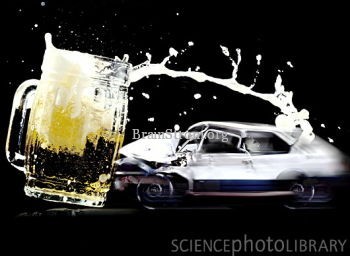Energy drinks, favored among young people for the beverages? caffeine jolt, also play a lead role in several popular alcoholic drinks, such as Red Bull and vodka. But combining alcohol and energy drinks may create a dangerous mix, according to University of Florida research. Energy drinks, favored among young people for the beverages’ caffeine jolt, also play a lead role in several popular alcoholic drinks, such as Red Bull and vodka. But combining alcohol and energy drinks may create a dangerous mix, according to University of Florida research. In a study of college-aged adults exiting bars, patrons who consumed energy drinks mixed with alcohol had a threefold increased risk of leaving a bar highly intoxicated and were four times more likely to intend to drive after drinking than bar patrons who drank alcohol only. The study appears in the April issue of the journal Addictive Behaviors. “Previous laboratory research suggests that when caffeine is mixed with alcohol it overcomes the sedating effects of alcohol and people may perceive that they are less intoxicated than they really are,” said the study’s lead researcher Dennis Thombs, an associate professor in the UF College of Public Health and Health Professions’ department of behavioral science and community health. “This may lead people to drink more or make uninformed judgments about whether they are safe to drive.” Experts believe that among college drinkers, as many as 28 percent consume alcohol mixed with energy drinks in a typical month. The UF study is the first of its kind to evaluate the effects of alcohol mixed with energy drinks in an actual drinking environment, that is, at night outside bars. Research on college student alcohol use in campus communities has traditionally relied on self-report questionnaires administered to sober students in daytime settings, Thombs said. Data for the UF study were collected in 2008 from more than 800 randomly selected patrons exiting establishments in a college bar district between the hours of 10 p.m. and 3 a.m. Researchers conducted face-to-face interviews with participants to gather demographic information and details on participants’ energy drink consumption and drinking behavior. Participants also completed self-administered questionnaires that asked about their drinking history and intention to drive that night. Next, researchers tested participants’ breath alcohol concentration levels. Participants received feedback on their intoxication levels and advice about driving risk. Bar patrons who reported drinking alcohol mixed with energy drinks — 6.5 percent of study participants — were three times more likely to be intoxicated than drinkers who consumed alcohol only. The average breath-alcohol concentration reading for those who mixed alcohol and energy drinks was 0.109, well above the legal driving limit of 0.08. Consumers of energy drink cocktails also left bars later at night, drank for longer periods of time, ingested more grams of ethanol and were four times more likely to express an intention to drive within the hour than patrons who drank alcohol only. Consumers of alcohol mixed with energy drinks may drink more and misjudge their capabilities because caffeine diminishes the sleepy feeling most people experience as they become intoxicated. It’s a condition commonly described as “wide awake and drunk,” said study co-author Bruce Goldberger, a professor and director of toxicology in the UF College of Medicine. “There’s a very common misconception that if you drink caffeine with an alcoholic beverage the stimulant effect of the caffeine counteracts the depressant effect of the alcohol and that is not true,” Goldberger said. “We know that caffeine aggravates the degree of intoxication, which can lead to risky behaviors.” The study, funded by the University of Florida Office of the President, raises a lot of questions and suggests topics for future research, Thombs said. “This study demonstrates that there definitely is reason for concern and more research is needed,” he said. “We don’t know what self-administered caffeine levels bar patrons are reaching, what are safe and unsafe levels of caffeine and what regulations or policies should be implemented to better protect bar patrons or consumers in general.” Thombs’ study is a very valuable addition to the existing body of research on the association of energy drink consumption and alcohol-related consequences, said Dr. Mary Claire O’Brien, an associate professor of emergency medicine and public health sciences at Wake Forest University who has studied the relationship between energy drink cocktails and high-risk behavior. “His approach is unique because it was conducted in a natural drinking environment — college bars,” O’Brien said. “His results clearly support the serious concern raised by previous research, that subjective drunkenness may be reduced by the concurrent ingestion of caffeinated energy drinks, increasing both the likelihood of further alcohol consumption, and of driving when intoxicated.” Provided by University of Florida
Thanks for installing the Bottom of every post plugin by Corey Salzano. Contact me if you need custom WordPress plugins or website design.

